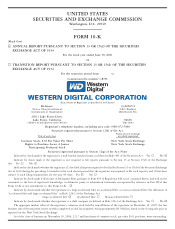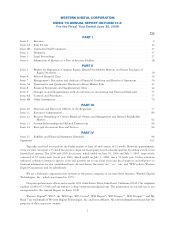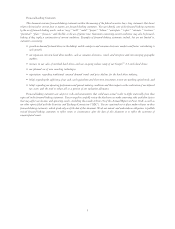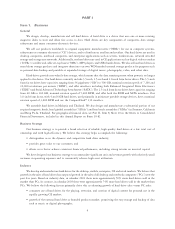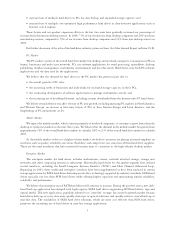Western Digital 2006 Annual Report Download - page 17
Download and view the complete annual report
Please find page 17 of the 2006 Western Digital annual report below. You can navigate through the pages in the report by either clicking on the pages listed below, or by using the keyword search tool below to find specific information within the annual report.and reliability, storage capacity, unit price, product performance, production volume capabilities, delivery capability,
leadership in time-to-market, time-to-volume and time-to-quality, service and support, and ease of doing business. The
relative importance of these factors varies between customer and market segments. We believe that we are generally
competitive in all of these factors.
We believe that there are no substantial barriers for existing competitors to offer competing products. Therefore, we
believe that we cannot differentiate WD hard drive products solely on attributes such as storage capacity, buffer size or
time-to-market. Accordingly, we differentiate WD by focusing on operational excellence, high product quality and
reliability, and designing and incorporating into our hard drives desirable product performance attributes. Such
performance attributes include seek times, data transfer rates, intelligent caching, failure prediction, remote diagnostics,
acoustics and data recovery. In addition, we emphasize non-product related attributes, including rapid response to our
customers. Rapid response requires accelerated design cycles, customer delivery, production flexibility and timely service
and support, which contribute to customer satisfaction. We also rely on the strength of the WD brand name with value-
added resellers and solution providers to whom we sell our hard drive products directly and indirectly. We believe that
trust in a manufacturer’s reputation, its execution track record and the establishment of strategic relationships have
become important factors in the selection of a hard drive, particularly in a rapidly changing technology environment.
Advances in magnetic, optical or other data storage technologies could result in competitive products with better
performance or lower cost per unit of capacity than our products. High-speed semiconductor memory could compete
with our hard drive products in the future. Semiconductor memory is much faster than magnetic hard drives, but
currently is not competitive from a cost standpoint. Flash memory, a non-volatile semiconductor memory, is currently
much more costly and, while it has higher “read” performance attributes than hard drives, it has lower “write”
performance attributes. Flash memory could become competitive in the near future for applications requiring less storage
capacity than that provided by hard drives.
For an additional discussion of risks related to competition, see Item 1A of this Annual Report on Form 10-K.
Service and Warranty
We generally warrant our newly manufactured hard drives against defects in materials and workmanship from one
to five years from the date of manufacture depending on the type of product. Our warranty obligation is generally limited
to repair or replacement of the hard drive. We have engaged third parties in Australia, Brazil, Canada, China, Germany,
Hungary, India, Korea, Russia, Singapore, Thailand and the United Arab Emirates to provide various levels of testing,
processing and/or recertification of returned hard drives for our customers. In addition, we process, test and recertify
returned hard drives at our facility in the United States.
Manufacturing
We believe that we have significant know-how, unique product manufacturing processes, execution skills and
human resources to continue to be successful and have the ability to grow, as necessary, our manufacturing operations. To
be competitive, we must manufacture high quality hard drives with industry leading time-to-volume production at
competitive unit costs. We strive to maintain manufacturing flexibility, high manufacturing yields, and reliable
products, while insisting that our suppliers provide high-quality components at competitive prices. The critical elements
of our hard drive production are high volume, low cost assembly and testing, and establishment and maintenance of key
supplier relationships. By establishing close relationships with our strategic component suppliers, we believe we access
best-of-class manufacturing quality. In addition, we believe that our sourcing strategy currently enables us to have the
business flexibility needed to select the highest quality low cost of ownership suppliers as product designs and
technologies evolve.
Hard drive manufacturing is a complex process involving the assembly of precision components with narrow
tolerances and thorough testing. The assembly process occurs in a “clean room” environment that demands skill in
process engineering and efficient space utilization to control the operating costs of this manufacturing environment. Our
clean room manufacturing process consists of modular production units, each of which contains a number of work cells.
We manufacture hard drives in Malaysia and Thailand. We continually evaluate our manufacturing processes in an
effort to increase productivity, sustain and improve quality and decrease manufacturing costs. For example, during 2002,
in response to an increase in demand and to capitalize on the local supplier base, we completed the acquisition of a
11


